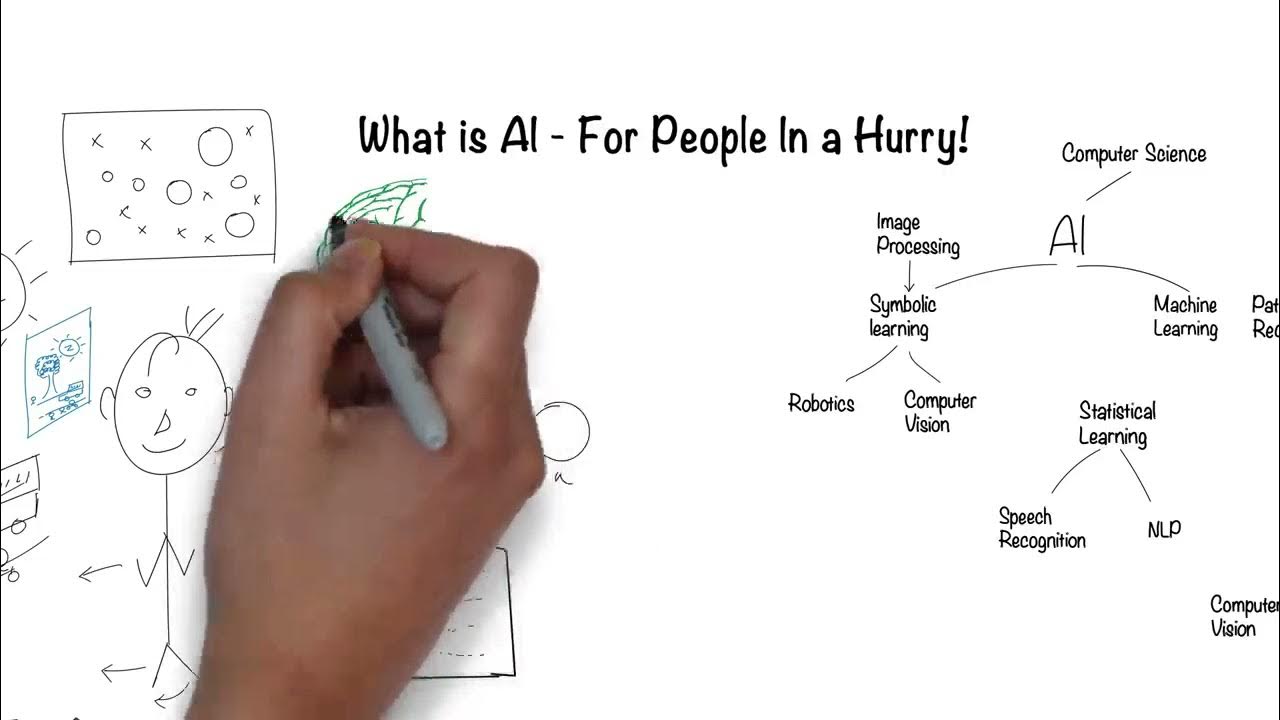El proceso de Knowledge Discovery (KDD)
Summary
TLDRThe script introduces the concept of Knowledge Discovery in Databases (KDD), an AI field that integrates machine learning, pattern recognition, statistics, and visualization to extract meaningful information from large datasets. It emphasizes the dynamic nature of KDD, which relies on user interaction and decision-making. The speaker illustrates KDD's process with an example of transforming data into insightful visualizations, such as population growth charts. The importance of hardware capabilities for processing data and the use of tools with extensive libraries are highlighted. The script concludes by discussing the need for systems to integrate well within existing environments to provide comprehensive solutions, ultimately aiming to satisfy user requirements and enhance decision-making.
Takeaways
- 🌟 Database discovery is a rapidly growing field in artificial intelligence that combines machine learning, pattern recognition, statistics, databases, and visualization to automatically extract knowledge from data.
- 🎓 The process of knowledge discovery is iterative and depends on user interaction for dynamic decision-making.
- 📊 It involves transforming data into visual representations, such as graphs, to illustrate growth or trends, like population statistics.
- 💾 The importance of structured and well-organized databases with filters and procedures to ensure accurate and meaningful results.
- 🖥️ The necessity of having capable hardware to process large amounts of data, including spatial and other complex data types.
- 🛠️ The use of tools with extensive libraries is suggested to assist in each step of the knowledge discovery process.
- 👥 The process is collaborative, involving groups working together to select appropriate tools and techniques to meet objectives.
- 🔍 The challenge of guiding users in the correct selection of tools and techniques to achieve their goals is an area of ongoing research.
- 🌐 Successful integration of the discovery system within an existing environment is crucial for providing a complete solution to analysts.
- 📈 The system should be user-friendly, displaying recent results and graphs to aid in decision-making and problem-solving.
- 📊 An example given is a retail scenario where the system can help identify the best-selling products, aiding in business strategy and profit maximization.
Q & A
What is the primary focus of the speaker's presentation?
-The speaker's presentation primarily focuses on the concept of Knowledge Discovery in Databases (KDD), which is a rapidly growing field in artificial intelligence that combines machine learning, pattern recognition, statistics, databases, and visualization to automatically extract knowledge or information from a database.
What does KDD stand for?
-KDD stands for Knowledge Discovery in Databases, which is a process that involves extracting useful knowledge from large volumes of data stored in databases.
What are the key techniques involved in KDD?
-The key techniques involved in KDD include machine learning, pattern recognition, statistics, database management, and data visualization.
Why is the process of KDD described as dynamic?
-The process of KDD is described as dynamic because it involves continuous interaction and depends on decision-making to adapt and respond to the evolving nature of data and user needs.
What role do filters and procedures play in the KDD process?
-Filters and procedures play a crucial role in the KDD process by structuring the data and ensuring that the results are relevant and meaningful for further analysis and decision-making.
How does the speaker illustrate the KDD process?
-The speaker illustrates the KDD process through a small example or 'drama' that shows how a well-structured database with filters and procedures can be transformed into meaningful insights through visualizations and data mining techniques.
What is the significance of data visualization in the KDD process?
-Data visualization is significant in the KDD process as it helps in representing complex data in a more understandable and interpretable format, such as graphs and charts, which can then be used to make informed decisions.
What does the speaker suggest about the importance of hardware in KDD?
-The speaker suggests that having a robust hardware infrastructure is crucial for processing the vast amounts of data involved in KDD, as it ensures that the data can be handled efficiently and effectively.
Why is user interaction considered essential in the KDD process?
-User interaction is considered essential in the KDD process because it allows for the tailoring of the discovery process to the specific needs and decisions of the user, making the process more relevant and effective.
What challenges are mentioned in the script regarding the selection of tools and techniques in KDD?
-The script mentions that one of the current research challenges in KDD is guiding users in the correct selection of tools and techniques to achieve their objectives, which is crucial for the success of the KDD process.
How does the speaker suggest improving the effectiveness of KDD systems?
-The speaker suggests that improving the effectiveness of KDD systems involves integrating them well within existing environments, providing a complete solution to analysts, and ensuring that the system is user-friendly and capable of delivering high-quality results that meet the requirements of the client or user.
Outlines

This section is available to paid users only. Please upgrade to access this part.
Upgrade NowMindmap

This section is available to paid users only. Please upgrade to access this part.
Upgrade NowKeywords

This section is available to paid users only. Please upgrade to access this part.
Upgrade NowHighlights

This section is available to paid users only. Please upgrade to access this part.
Upgrade NowTranscripts

This section is available to paid users only. Please upgrade to access this part.
Upgrade Now5.0 / 5 (0 votes)





